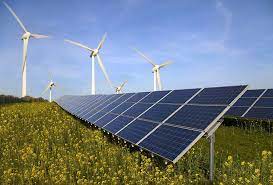Courtesy : en.wikipedia.org
India new renewal energy policy
India is world’s 3rd largest consumer of electricity and world’s 3rd largest renewable energy producer with 40% of energy capacity installed in the year 2022 (160 GW of 400 GW) coming from renewable sources. Ernst & Young’s (EY) 2021 Renewable Energy Country Attractiveness Index (RECAI) ranked India 3rd behind USA and China.In November 2021, India had a renewable energy capacity of 150 GW consisting of solar (48.55 GW), wind (40.03 GW), small hydro power (4.83 GW), bio-mass (10.62 GW), large hydro (46.51 GW), and nuclear (6.78 GW). India has committed for a goal of 500 GW renewable energy capacity by 2030.
In 2016, Paris Agreement’s Intended Nationally Determined Contributions targets, India made commitment of producing 50% of its total electricity from non-fossil fuel sources by 2030. In 2018, India’s Central Electricity Authority set a target of producing 50% of the total electricity from non-fossil fuels sources by 2030. India has also set a target of producing 175 GW by 2022 and 500 GW by 2030 from renewable energy.
As of September 2020, 89.22 GW solar energy is already operational, projects of 48.21 GW are at various stages of implementation and projects of 25.64 GW capacity are under various stages of bidding. In 2020, 3 of the world’s top 5 largest solar parks were in India including world’s largest 2255 MW Bhadla Solar Park in Rajasthan and world’s second-largest solar park of 2000 MW Pavgada Solar Park Tumkur in Karnataka and 100 MW Kurnool in Andhra Pradesh.Wind power in India has a strong manufacturing base with 20 manufactures of 53 different wind turbine models of international quality up to 3 MW in size with exports to Europe, United States and other countries.
Solar, wind and run-of-the-river hydroelectricity are environment-friendly cheaper power sources they are used as “”must-run” sources in India to cater for the base load, and the polluting and foreign-import dependent coal-fired power is increasingly being moved from the “must-run base load” power generation to the load following power generation (mid-priced and mid-merit on-demand need-based intermittently-produced electricity) to meet the peaking demand only. Some of the daily peak demand in India is already met with the renewable peaking hydro power capacity. Solar and wind power with 4-hour battery storage systems, as a source of dispatchable generation compared with new coal and new gas plants, is already cost-competitive in India without subsidy.
India initiated the International Solar Alliance (ISA), an alliance of 121 countries. India was world’s first country to set up a ministry of non-conventional energy resources (Ministry of New and Renewable Energy (MNRE) in early 1980s) . Solar Energy Corporation of India (SECI), a public sector undertaking, is responsible for the development of solar energy industry in India. Hydroelectricity is administered separately by the Ministry of Power and not included in MNRE targets.
Global comparison
Global rank
India ranks second in terms of population and accounts for 17% of the world’s population. India is globally ranked 3rd in consumption of energy. In terms of installed capacity and investment in renewable energy, the EY’s Renewable Energy Country Attractiveness Index (RECAI) ranking in July 2021 is as follows:
| Country | Score | RECAI Rank |
|---|---|---|
| USA | 70.7 | 1 |
| China | 68.7 | 2 |
| India | 66.2 | 3 |
Attractiveness score
The technology-specific RECAI scores (and rank) in 2021 are as follows:
Future targets
The government has announced that no new coal-based capacity addition is required beyond the 50 GW under different stages of construction likely to come online between 2017 and 2022.



